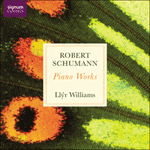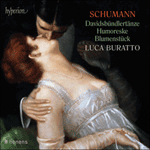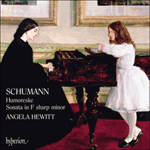
Welcome to Hyperion Records, an independent British classical label devoted to presenting high-quality recordings of music of all styles and from all periods from the twelfth century to the twenty-first.
Hyperion offers both CDs, and downloads in a number of formats. The site is also available in several languages.
Please use the dropdown buttons to set your preferred options, or use the checkbox to accept the defaults.


Not to have written to you for a week, is that right? But I have been rhapsodizing about you, and have thought of you with a love such as I have never experienced before. The whole week I have been sitting at the piano, composing and writing, laughing and crying all at once. All this you will find nicely portrayed in my Op 20, the grand Humoreske, which is also about to be engraved. You see, that’s how quickly things go with me: conceived, written out and printed. And that’s how I like it. Twelve sheets completely written out in a week.
The conflicting emotions Schumann felt while composing his Humoreske are reflected in the music’s contrasting moods, or ‘humours’. In a letter of 15 March 1839 to his Belgian follower Simonin de Sire, Schumann provided a hint as to the meaning of the work’s title when he pointed out that the word ‘humoreske’ couldn’t adequately be translated into French. ‘It is a pity’, said Schumann, ‘that there are no good and apt words in the French language for such deeply ingrained characteristics and concepts as Gemütlichkeit, and for humour, which is the happy fusion of the gemütlich and the witty. But it is this that binds the whole character of the two nations together.’ The previous year, in drawing de Sire’s attention to his F sharp minor sonata, Op 11, and the Fantasiestücke, Op 12, Schumann told him: ‘The human heart sometimes seems strange, and pain and joy are intermingled in wild variegation.’
The Humoreske has one of the most beautiful openings in all Schumann: a song-like melody that begins away from the tonic, as though the music were starting in mid-stream. The note F sharp with which the melody begins—the home key is B flat major—has long-term implications: it presages first a middle section in G flat major (the aural equivalent of F sharp), with the pianist’s left hand effortlessly and undemonstratively in canon with the right; and secondly, a similar turn of harmonic events in the first of the ensuing quick sections. The opening number itself is cast in a symmetrical arch-like structure, with the initial slow material returning at the close. (Its emergence as a tempo ‘dissolve’ out of the preceding fast section is a remarkable stroke.)
The opening bars of the second number have given rise to much speculation. The music is notated on three staves, with the middle stave designated as an ‘inner voice’. Attempts to link its melodic outline to that of a Romance by Clara Wieck written around the same time have been less than wholly convincing. More likely is that the additional stave merely indicates the melodic shape implicit in the syncopated swirl of semiquavers at the top of the texture, and that the ‘inner voice’ is to be imagined by the pianist, rather than actually played. If it is a secret message to Clara, it has yet to be decoded.
There is further curious syncopation later on in this second piece, with the pianist’s left hand acting as a sort of timekeeper while the right is instructed to play ‘as though out of tempo’. From this point on, the music gradually accelerates, until the outline of the material surrounding the ‘inner voice’ suddenly returns in the form of a series of long-held chords, as though the music had become frozen into immobility. This wholly unexpected moment of stasis takes the place of any reprise of the initial eight bars of the piece, and the opening section’s swirling figuration is duly rejoined at what had been the ninth bar. It is one of the most remarkable returns in all Schumann, and the source, perhaps, of similarly overlapping recapitulations in Brahms, perhaps the most striking of which occurs in the opening movement of his fourth symphony.
The following number contrasts a tender G minor melody with a rapid intermezzo in the relative major (B flat). The intermezzo confronts the pianist with a technical challenge: its rapid semiquaver figuration occurs at one point in octaves for the right hand—a passage that may have been marginally less daunting on the instruments of Schumann’s day, with their slightly narrower keys (which would have allowed for more of the octaves to be ‘fingered’) and shallower action.
The last piece in the cycle is more open-ended than its predecessors. It is, indeed, a not so miniature Humoreske in itself. Its opening section returns to the mood and harmonic outline of the work’s beginning; but this reflective passage eventually gives way to an agitated episode written very much in the style of Schumann’s Kreisleriana. (It is strikingly similar to one of the intermezzi in the second piece of that earlier work.) This in turn accelerates, to form what promises to be a vertiginous conclusion to the work as a whole. At this point, however, Schumann the satirist steps in, with an exaggeratedly pompous march which fades slowly away, to give rise to the final section: a characteristically Schumannesque ‘end of story’, complete with passages that hint at a recitative style. Finally, as if to shrug off the notion of a poetic conclusion of that kind, Schumann introduces an energetic allegro which brings the work to a firm, if abrupt, close.
from notes by Misha Donat © 2017
Ne pas t’avoir écrit pendant une semaine, est-ce juste? Mais je t’ai aimée passionnément et j’ai rêvé de toi, et avec quel amour. Je n’avais encore jamais éprouvé rien de tel. Je suis resté assis à mon piano pendant toute la semaine et j’ai composé, écrit, ri et pleuré, tout à la fois; tu trouveras tout cela joliment dépeint dans mon op.20, la grande Humoresque, qui est déjà à l’impression. Voilà comment, maintenant, cela marche avec moi. Au galop! Créer, transcrire et être imprimé. Voilà ce qui me plaît. J’ai complètement terminé une douzaine de feuillets en huit jours.
Les émotions contradictoires que Schumann ressentait pendant qu’il composait l’Humoresque se reflètent dans les atmosphères contrastées, ou «humeurs», de la musique. Dans une lettre du 15 mars 1839 à l’un de ses admirateurs, le Belge Simonin de Sire, Schumann donna une idée de la signification du titre de cette œuvre lorsqu’il souligna que le mot «humoreske» ne pouvait se traduire de manière adéquate en français. Il dit: «C’est dommage qu’il n’y ait pas de termes appropriés en français pour des notions et particularismes aussi enracinés dans la nation allemande que Gemütlichkeit et Humor, lequel est précisément un mélange heureux de Gemütlich et d’esprit farceur. Mais c’est cela qui lie toute la nature des deux nations.» L’année précédente, en attirant l’attention de Simonin de Sire sur sa sonate en fa dièse mineur, op.11, et sur les Fantasiestücke, op.12, Schumann lui dit: «Le cœur humain semble parfois étrange, et la souffrance et la joie se mélangent dans une diversité délirante.»
Le début de l’Humoresque est l’un des plus beaux de toute la musique de Schumann: une mélodie qui ressemble à un lied et qui commence loin de la tonique, comme si la musique commençait à mi-parcours. La note fa dièse avec laquelle débute la mélodie (la tonalité de base est si bémol majeur) a des implications à long terme: elle présage tout d’abord une section médiane en sol bémol majeur (l’équivalent à l’oreille de fa dièse), la main gauche du pianiste intervenant en canon avec la main droite sans effort et de manière peu démonstrative ; puis vient une tournure analogue des événements harmoniques dans la première des sections rapides suivantes. Le premier numéro lui-même est coulé dans une structure symétrique en forme d’arche, le matériel lent initial revenant à la fin (son émergence à un tempo «diminué» à la fin de la section rapide précédente est un procédé remarquable).
Les premières mesures du deuxième numéro ont donné lieu à de nombreuses spéculations. La musique est notée sur trois portées, la portée du milieu étant désignée comme une «voix intérieure». Certains rapprochements de son contour mélodique avec celui d’une Romance de Clara Wieck écrite à peu près à la même époque ne sont pas vraiment convaincants. Il semblerait plutôt que la portée supplémentaire indique simplement la forme mélodique implicite dans le tourbillon de doubles croches syncopées au sommet de la texture et que la «voix intérieure» doive être imaginée par le pianiste, plutôt que d’être vraiment jouée. S’il s’agit d’un message secret à Clara, il faut encore le décoder.
Un peu plus tard dans cette deuxième pièce, on trouve d’autres syncopes étranges, la main gauche du pianiste agissant comme une sorte de chronomètre tandis qu’il est demandé à la main droite de jouer «comme en dehors du tempo». À partir de là, la musique accélère peu à peu, jusqu’au retour soudain du matériel entourant la «voix intérieure» sous la forme d’une série d’accords longuement tenus, comme si la musique s’était figée. Ce moment de stagnation totalement inattendu tient lieu de reprise des huit premières mesures de la pièce et la figuration tourbillonnante de la section initiale est rejointe comme prévu à l’emplacement de la neuvième mesure. C’est l’un des plus remarquables retours dans toute la musique de Schumann et peut-être la source de réexpositions qui se chevauchent de la même façon chez Brahms, dont l’exemple le plus frappant se présente sans doute dans le premier mouvement de sa symphonie nº 4.
Le numéro suivant fait ressortir le contraste entre une tendre mélodie en sol mineur et un intermezzo rapide au relatif majeur (si bémol). L’intermezzo confronte le pianiste à un défi technique: sa figuration en doubles croches rapides se transforme à un certain moment en octaves à la main droite—un passage qui posait peut-être moins de problèmes sur les instruments de l’époque de Schumann, avec leur mécanisme moins profond et leurs touches un peu plus étroites (qui permettait peut-être de «doigter» un plus grand nombre d’octaves).
La dernière pièce de ce cycle est plus ouverte que les précédentes. En fait, cette Humoresque n’est pas si miniature que ça. La section initiale revient à l’atmosphère et au contour harmonique du début de l’œuvre; mais ce passage profond fait finalement place à un épisode agité écrit dans un style très proche des Kreisleriana de Schumann (il ressemble de manière frappante à l’un des intermezzi de la deuxième pièce de cette œuvre antérieure). À son tour, ce passage accélère pour former ce qui promet d’être une conclusion vertigineuse de l’œuvre dans son ensemble. Pourtant, à ce point, Schumann le satiriste intervient avec une marche exagérément pompeuse qui s’éteint lentement, pour donner naissance à la section finale: une «fin de l’histoire» typique de Schumann, avec des passages qui font allusion à un style récitatif. Pour finir, comme pour ignorer la notion d’une conclusion poétique de ce genre, Schumann introduit un allegro énergique qui mène l’œuvre à une fin définitive, bien que brusque.
extrait des notes rédigées par Misha Donat © 2017
Français: Marie-Stella Pâris
Dir über acht Tage lang nicht zu schreiben, ist das recht? Aber geschwärmt hab ich in Dir, und mit einer Liebe an Dich gedacht, wie ich schon gar nicht gekannt. Die ganze Woche saß ich am Klavier und componirte und schrieb und lachte und weinte durcheinander; dies findest Du nun Alles schön abgemalt in meinem Op. 20, d. großen Humoreske, die auch schon gestochen wird. Sieh, so schnell geht es jetzt bei mir. Erfunden, aufgeschrieben und gedruckt. Und so hab’ ich’s gerne. Zwölf Bogen in acht Tagen fertig geschrieben.
Die widerstreitenden Gefühle, die Schumann während der Komposition der Humoreske empfand, spiegeln sich in den Stimmungskontrasten des Stücks wider, in seinen „Humoren“, verstanden als Launen. In einem Brief vom 15. März 1839 an seinen belgischen Anhänger Simonin de Sire gab Schumann einen Hinweis auf die Bedeutung des Werktitels, als er anmerkte, man könne das Wort „Humoreske“ nicht treffend ins Französische übersetzen. „Es ist schlimm, daß gerade für die in der deutschen Nationalität am tiefsten eingewurzelten Eigenthümlichkeiten und Begriffe wie für das Gemütliche (Schwärmerische) und für den Humor, der die glückliche Verschmelzung von Gemüthlich und Witzig ist, keine guten und treffenden Worte in der französischen Sprache vorhanden sind. Es hängt dieses aber mit dem ganzen Charakter der beiden Nationen zusammen.“ Als er Jahr zuvor de Sire auf seine fis-Moll-Sonate, op. 11, und die Fantasiestücke, op. 12, hinwies, schrieb Schumann ihm: „Sonderbar sieht es manchmal im Menschenherzen aus, und Schmerz und Freude durchkreuzen sich in wilder Buntheit.“
Der Beginn der Humoreske zählt zu den schönsten Werkanfängen in Schumanns gesamtem Schaffen: eine liedhafte Melodie, die fern der Grundtonart anhebt, so als finge die Musik mittendrin an. Der Ton Fis, mit dem die Melodie beginnt—Grundtonart ist B-Dur—hat Auswirkungen bis weit ins Stück hinein: Sie ist die Vorahnung erstens eines Mittelteils in Ges-Dur (der enharmonischen Verwechslung von Fis-Dur), in dem die linke Hand des Spielers ganz zwanglos und ohne Aufhebens im Kanon mit der rechten geführt wird; zweitens nimmt sie eine ähnliche Wendung der Harmonik im ersten der beiden folgenden raschen Abschnitte vorweg. Das Eröffnungsstück selber ist in symmetrischer Bogenform gehalten; das langsame Material des Beginns kehrt zum Schluss wieder. (Bemerkenswert und überraschend ist, wie es sich aus der Auflösung des vorhergehenden schnellen Abschnitts ergibt.)
Die Anfangstakte der zweiten Nummer haben Anlass zu vielerlei Spekulationen gegeben. Sie sind auf drei Systemen notiert, das mittlere ist als „innere Stimme“ bezeichnet. Es wurde versucht, ihr melodisches Profil mit einer Romance Claras aus etwa derselben Zeit in Beziehung zu setzen, allerdings wenig überzeugend. Wahrscheinlicher ist es, dass das zusätzliche System lediglich die melodische Kontur aufzeigen soll, die sich im Wirbel der Sechzehntel an der Oberfläche des Satzes verbirgt, und dass der Pianist sich die „innere Stimme“ vorstellen soll, statt sie tatsächlich zu spielen. Sollte sich dahinter eine geheime Botschaft an Clara verbergen, so harrt sie noch ihrer Entzifferung.
Im weiteren Verlauf des Stücks kommt es zu eigentümlichen Synkopen: Die linke Hand des Spielers spielt die Rolle eines Taktgebers, während die rechte die Anweisung „Wie außer Tempo“ erhält. Von hier an beschleunigt sich die Musik nach und nach, bis plötzlich die Umrisse des Materials, das zuvor die „innere Stimme“ umgibt, als Folge lang ausgehaltener Akkorde wiederkehren—als sei die Musik plötzlich zur Unbeweglichkeit erstarrt. Dieser unvorhergesehene Moment des Stillstands übernimmt den Platz der Reprise der acht Anfangstakte des Satzes, und die wirbelnden Figurationen des Anfangsabschnitts setzen wieder mit deren neuntem Takt ein. Es ist eine der eigentümlichsten Reprisen bei Schumann überhaupt und vielleicht das Vorbild für ähnlich in die Reprise hineinragende Abschnitte bei Brahms, am auffälligsten im Kopfsatz von dessen 4. Sinfonie.
Die folgende Nummer kontrastiert eine zarte Melodie in g-Moll mit einem raschen Intermezzo in der Paralleltonart B-Dur. Das Intermezzo stellt den Pianisten vor eine besondere Schwierigkeit: Seine rasenden Sechzehntelfigurationen erscheinen an einer Stelle in Oktaven für die rechte Hand; eine Passage, die auf den Instrumenten der Schumann-Zeit vielleicht etwas weniger halsbrecherisch war, denn diese besaßen schmalere Tasten—sodass man die Passage mit Fingersatz-Oktaven spielen konnte—mit weniger Tiefgang.
Das Schlussstück des Zyklus’ endet noch offener als seine Vorgänger. Es bildet eine Humoreske für sich—allerdings wäre es nicht übertrieben, es „Humoreske en miniature“ zu nennen. Sein Beginn kehrt zur Stimmung und Harmoniefolge des Werkanfangs zurück; doch diese nachdenkliche Passage weicht bald einer erregten Episode, deren Stil an Schumanns Kreisleriana erinnert (sie ähnelt stark einem der Intermezzi im zweiten Stück des älteren Werks). Diese beschleunigt sich weiter, und man erwartet den schwindelerregenden Abschluss des ganzen Werks. Da jedoch tritt der Satiriker Schumann auf den Plan mit einem übertrieben pompösen Marsch, der langsam verebbt, um dem Schlussabschnitt Raum zu geben, einem für Schumann typischen „Ende der Geschichte“—wie es sich gehört, mit rezitativartigen Abschnitten. Schließlich lässt Schumann, als wollte er die Idee eines solchen poetischen Schlusses abschütteln, ein drängendes Allegro einbrechen, das das Werk zu einem knappen, aber entschlossenen Schluss führt.
aus dem Begleittext von Misha Donat © 2017
Deutsch: Friedrich Sprondel
 Schumann: Piano Works Schumann: Piano WorksLlŷr Williams’ long and successful collaboration with Signum Records continues with this survey of Schumann’s piano works, beginning with the early 'Papillons' completed when he was just twenty.» More |
 Schumann: Davidsbündlertänze, Humoreske & Blumenstück Schumann: Davidsbündlertänze, Humoreske & BlumenstückHyperion is thrilled to present the debut studio recording of 2015 Honens Prize Laureate Luca Buratto in an all-Schumann programme: two large-scale masterpieces and an exquisite miniature.» More |
 Schumann: Humoreske & Sonata Op 11 Schumann: Humoreske & Sonata Op 11 |

